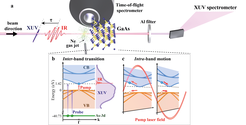Milestone study of excitation of GaAs electrons at attosecond level

Fabian Schlaepfer and his colleagues in the experimental group of Ursula Keller at the Institute for Quantum Electronics at ETH Zurich, together with Angel Rubio and Shunsuke Sato from the MPSD’s Theory department, combined transient absorption spectroscopy with sophisticated first-principles calculations to study and understand these processes. Their work has now appeared online in Nature Physics.
Gallium arsenide is a technologically important narrow-band-gap semiconductor, in which the excitation of electrons from the valence into the conduction band produces charge carriers that can transport electrical current through electronics components.
In addition to this so-called inter-band transition, carriers can also be accelerated within the individual bands as the electrons interact with the laser light. This intra-band motion is caused by the strong electric field associated with the laser light.
Which of the two mechanisms dominates the response to a short intense laser pulse, and how their interplay effects the carrier injection into the conduction band, is far from obvious.
The researchers found that intra-band motion does play an important role, as it significantly enhances the number of electrons that get excited into the conduction band. This finding was unexpected because intra-band motion alone is unable to produce charge carriers in the conduction band.
Their work has also now revealed that the nonlinear interplay between intra- and inter-band transitions opens a new excitation channel via virtually excited states at high pump intensities.
These results represent an important step forward in understanding the light-induced electron dynamics in a semiconductor on the attosecond timescale. The processes will be of practical relevance for future electronics and optoelectronics devices, whose dimensions become ever smaller and involve ever faster dynamics and ever stronger electric fields.












